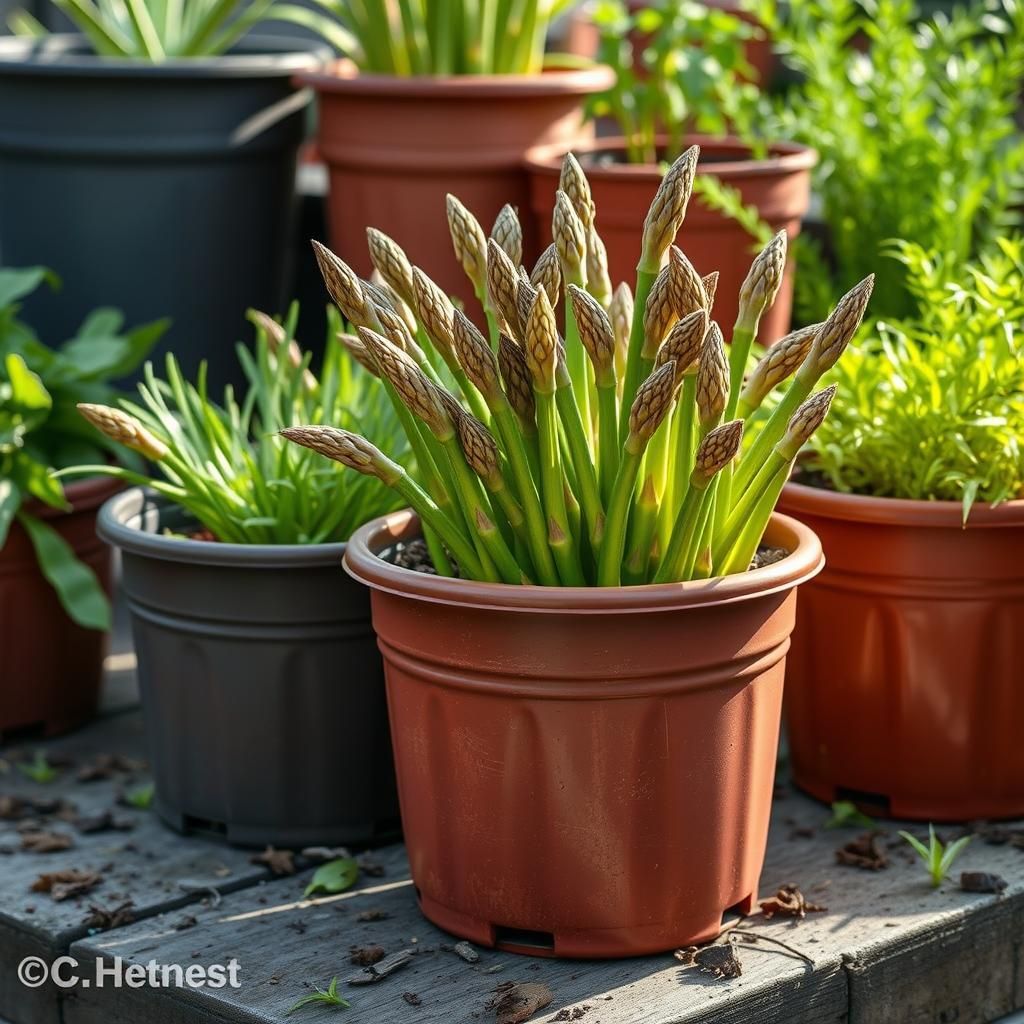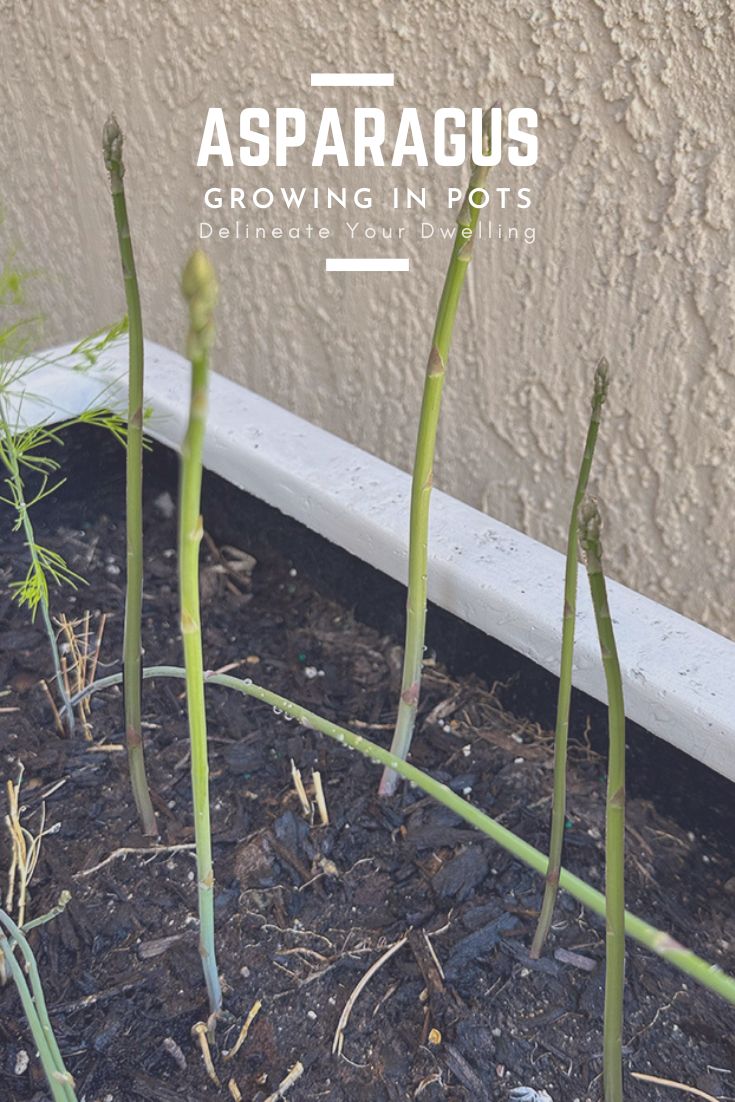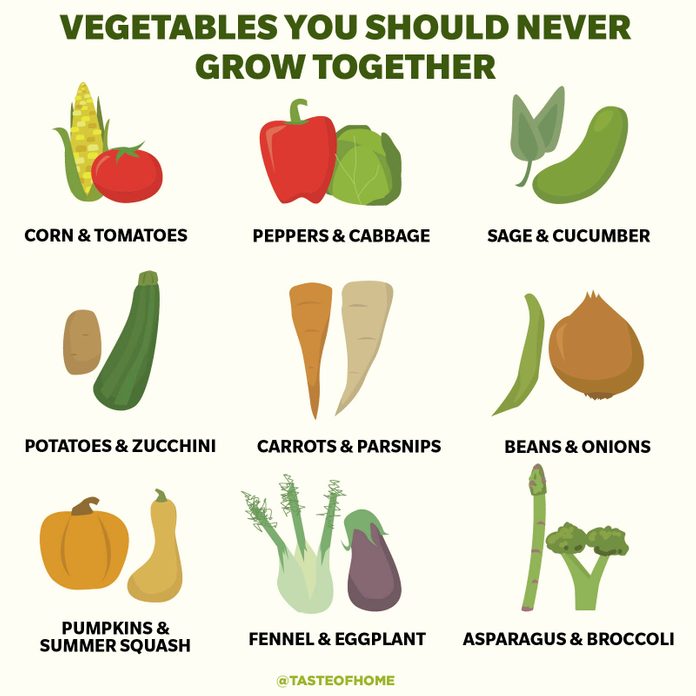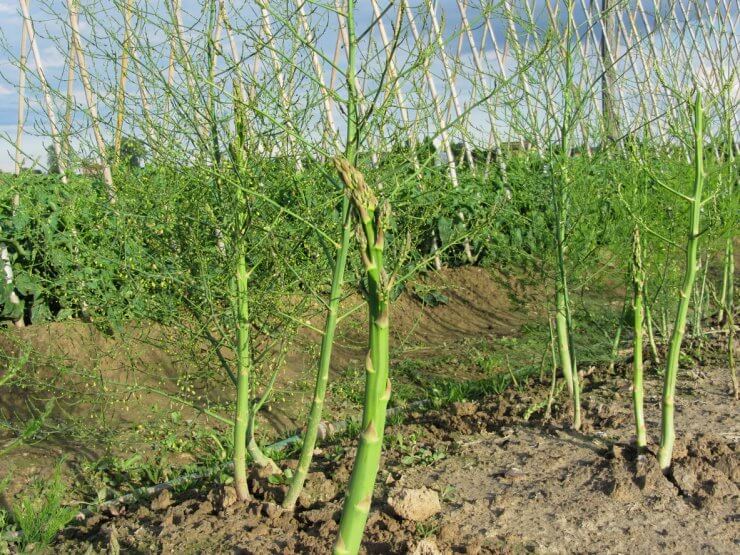The Ultimate Guide to Growing Asparagus in Containers: Tips and Tricks for Success

Asparagus is a delicious and nutritious vegetable that can thrive in containers, making it an ideal choice for gardeners with limited space. Growing asparagus in pots allows you to customize your planting conditions and create a manageable garden that can beautify any patio or balcony. However, successful container cultivation requires specific techniques to ensure healthy growth and bountiful harvests. In this ultimate guide, we will explore essential tips and tricks for growing asparagus in containers, covering everything from selecting the right varieties to optimal soil mixes, watering routines, and harvesting strategies. Get ready to enjoy this gourmet delicacy right from your home!
Growing Asparagus in Containers: A Practical Guide
Growing asparagus in containers is an excellent way to cultivate this perennial vegetable even in limited spaces. Asparagus requires deep soil for its root system, and using a large container ensures that it has enough room to thrive. Choose a pot that is at least 12-18 inches deep and wide, and use well-draining potting soil that is rich in organic matter. Keep the container in a sunny location, as asparagus requires full sunlight for optimal growth. Additionally, ensure consistent watering, but make sure not to overwater, as this can lead to root rot. With patience and proper care, you can successfully grow asparagus in containers and enjoy fresh spears right from your patio or balcony.
Choosing the Right Container
Selecting the appropriate container is crucial for growing asparagus successfully. A container should be at least 12-18 inches deep to accommodate the long root system of asparagus. You can opt for plastic, wood, or ceramic pots, ensuring they have adequate drainage holes. Using a larger container not only helps with the plant's growth but also makes it easier to manage moisture levels. A pot with a wide diameter is also recommended, as asparagus plants can spread out over time and require ample space to flourish.
Soil Requirements for Asparagus
Asparagus thrives in well-draining soil that is high in nutrients. A mix of potting soil and compost can create an ideal environment for growth. Make sure the soil pH is between 7.0 and 8.0, as asparagus prefers slightly alkaline conditions. Adding organic fertilizers throughout the growing season will help support the plant’s nutritional needs. It's crucial to avoid compacted soil as it can hinder root growth and lead to poor drainage, which can ultimately affect the health of the asparagus plants.
Planting Techniques
When planting asparagus in containers, it's essential to follow proper techniques for maximum yield. Begin by placing the container in its desired location before planting, as it can be heavy once filled with soil. Create a trench in the soil about 6-8 inches deep and place asparagus crowns in the trench, making sure to spread the roots out. Cover the crowns lightly with soil, and water thoroughly after planting. It's best to plant asparagus in the spring when the soil has warmed up, ensuring that the plants have a longer growing season to establish themselves.
Watering and Fertilizing Needs
Asparagus requires consistent moisture, especially during its first growing season. Water the plants deeply but infrequently to encourage deep root growth. During hot weather, you may need to increase watering frequency, but be cautious of overwatering, as it can lead to root rot. Fertilize your asparagus plants with a balanced organic fertilizer every few weeks during the growing season. This approach will provide the necessary nutrients and promote healthy growth.
Pest and Disease Management
Despite being relatively hardy, asparagus can fall victim to various pests and diseases. Common pests include aphids and asparagus beetles, which can harm the plants by feeding on them. Regular inspection and the introduction of natural predators can help manage these pests. Additionally, keeping the container clean and free from debris can minimize the risk of diseases such as fungal infections. If disease does strike, using organic fungicides can be an effective solution to maintain healthy asparagus plants.
| Aspect | Details |
|---|---|
| Container Depth | 12-18 inches |
| Soil Type | Well-draining, nutrient-rich |
| Watering | Deep and infrequent |
| Fertilization | Balanced organic fertilizer |
| Pest Management | Natural predators, organic fungicides |
Does asparagus do well in containers?

Yes, asparagus can do well in containers, provided that specific conditions are met. Growing asparagus in containers offers several advantages, including the ability to control soil quality, moisture levels, and easier pest management. However, successful cultivation requires careful attention to the type of container, soil, and climate.
One important factor is the size of the container. Asparagus plants have extensive root systems, requiring ample space for healthy growth. A container that is at least 5 gallons in size is recommended for optimal results. Moreover, ensuring that the container has proper drainage is crucial because asparagus does not tolerate waterlogged soil.
When it comes to soil, utilizing a high-quality potting mix that retains moisture but drains well is essential. You can also enhance the soil with organic fertilizers to support the growth of vigorous asparagus spears. Regular watering and full sun exposure (at least 6-8 hours daily) are critical for productivity.
See also:
In terms of timing, patience is key, as it can take about 2 to 3 years after planting for asparagus to produce a harvestable yield. Once established, asparagus can yield for many years, making it a worthwhile investment in container gardening.
Container Size and Type
Choosing the right container is vital for successful asparagus growth. Containers should be large enough to accommodate the plant's root system and provide adequate soil volume.
- Material: Opt for durable materials like ceramic, plastic, or wooden containers.
- Size: A minimum of 5 gallons is recommended to support healthy growth.
- Shape: Choose deep containers to allow for root expansion.
Soil Requirements
Asparagus thrives best in well-draining soil that retains moisture without becoming waterlogged. A high-quality potting mix is ideal for container-grown plants.
- Potting mix: Ensure it contains organic matter for nutrient enrichment.
- pH level: Aim for a soil pH between 7.0 and 8.0 for optimal growth.
- Fertilization: Use organic fertilizers to encourage healthy spears.
Watering and Moisture
Proper watering is essential to asparagus growth in containers. The plants prefer consistently moist but not soggy soil.
- Frequency: Water regularly, especially during hot weather.
- Drainage: Make sure containers have drainage holes to avoid root rot.
- Mulching: Consider adding mulch to retain soil moisture.
Sunlight Requirements
Asparagus requires plenty of sunlight to thrive, ideally receiving 6 to 8 hours of direct sunlight each day.
- Location: Place containers in a sunny spot for optimal growth.
- Shade: Ensure that taller plants do not cast shade on the asparagus containers.
- Seasonal shift: Be mindful of changing light conditions throughout the seasons.
Harvesting and Maintenance
Patience is vital as asparagus takes a couple of years to become established for harvesting. Maintenance includes monitoring growth and managing pests.
- Timing: Wait until the third year before harvesting spears.
- Cutting: Trim spears at ground level when they reach 6 to 8 inches tall.
- Pest management: Keep an eye out for common pests and act quickly to manage infestations.
What should you not plant next to asparagus?

Asparagus is a perennial vegetable that thrives when grown in optimal conditions and can be quite sensitive to neighboring plants. Here are the plants you should avoid planting next to asparagus:
Companions to Avoid
Asparagus has specific plants that should not be grown nearby due to competition for nutrients and possible negative interactions. These include:
- Beans - They can fix nitrogen in the soil, which can disrupt the nutrient balance that asparagus prefers.
- Cabbage family - Members of the Brassicaceae family can compete for space and resources, inhibiting the growth of asparagus.
- Onions - While productive, they can create competition for water and nutrients, which asparagus need in larger quantities.
Pest Management Concerns
Certain plants near asparagus can attract pests that harm them, impacting overall health and yield. Avoid these:
- Tomatoes - They can attract pests like aphids, which also affect asparagus.
- Potatoes - They share similar pests and diseases, complicating pest control efforts.
- Alliums - Onions and garlic can attract pests that may also have an effect on asparagus crop health.
Nutrient Competition
Asparagus requires specific nutrients for optimal growth, and certain plants can compete for these essential resources:
See also:
- Carrots - They need similar nutrients and can inhibit asparagus's nutrient absorption.
- Beets - These root vegetables compete with asparagus for water and nutrients.
- Chard - High nutrient demand can exhaust the soil, negatively impacting asparagus growth.
Soil pH Considerations
Soil pH is crucial for asparagus growth, and some plants can alter the pH level unfavorably:
- Blueberries - They prefer acidic soil, which can conflict with asparagus's preferred pH range.
- Azaleas - Similar to blueberries, these can acidify the soil, harming asparagus productivity.
- Rhododendrons - Their soil requirements can lead to an unsuitable growing environment for asparagus.
Long-Term Growth Interference
Lastly, some plants can disrupt the long-term growth and sustainability of an asparagus patch:
- Perennial weeds - These can invade and take over, leading to competition for resources.
- Sunflowers - They grow tall and can shade asparagus, limiting its access to sunlight.
- Hostas - While decorative, they can compete for moisture and nutrients needed by asparagus.
Does asparagus grow better in sun or shade?

Asparagus is a perennial vegetable that thrives best in full sun conditions. Growing asparagus in direct sunlight promotes healthy growth, supports high yields, and enhances the flavor of the spears. Ideally, asparagus needs at least 6 to 8 hours of sunlight each day to reach its full potential. When grown in shade, asparagus may exhibit slower growth rates and lower production, as the lack of sunlight can hinder photosynthesis, which is essential for plant vitality.
Optimal Sun Exposure for Asparagus
Asparagus requires significant sun exposure to flourish. The plant's need for sunlight can be explained through the following points:
- Photosynthesis: Sunlight is vital for the photosynthesis process, allowing the plant to convert light energy into food.
- Growth Rate: With adequate sunlight, asparagus can grow faster and produce more spears in a shorter period.
- Flavor Development: Sunlit conditions contribute to the sweetness and flavor intensity of asparagus, making it more desirable for consumption.
Effects of Shade on Asparagus Growth
Growing asparagus in shaded conditions could lead to several adverse effects on the plant. Key issues arising from insufficient sunlight include:
- Reduced Yield: Asparagus grown in shade tends to produce fewer spears, impacting the overall harvest.
- Weak Foliage: Lack of sunlight may result in spindly and weakened plant structure, leading to susceptibility to diseases.
- Delayed Maturity: As plants receive less light, this may prolong the time needed for spears to mature, affecting the harvesting schedule.
Choosing the Right Location for Asparagus
Selecting an appropriate planting site is crucial for the success of asparagus cultivation. When determining the best location, consider the following factors:
- Sun Position: Observe the sunlight patterns in your garden to find areas that receive prolonged sun exposure throughout the day.
- Vegetation Nearby: Avoid planting near tall trees or buildings that may block sunlight, especially during the critical morning hours.
- Drainage: Ensure that the location also provides good drainage, as asparagus does not thrive in waterlogged conditions.
Best Practices for Growing Asparagus in Full Sun
To maximize the benefits of growing asparagus in full sun, gardeners can follow these best practices:
- Soil Preparation: Amend the soil with organic matter to improve fertility and moisture retention before planting.
- Watering Schedule: Maintain a consistent watering regimen, especially during hot periods, to keep the soil evenly moist.
- Mulching: Apply mulch around the base to retain soil moisture and suppress competing weed growth.
Conclusion on Sun vs. Shade for Asparagus
While the final thoughts on growing asparagus under different lighting conditions are not stated, it is clear from the evidence presented that asparagus heavily favors sunny locations over shaded ones.
Questions from Our Readers
Can asparagus be grown in containers?
Yes, asparagus can be grown in containers, making it an excellent choice for those with limited garden space. It is important to choose a large container that provides adequate depth and drainage, as asparagus has a long growing season and requires ample room for its roots to expand.
What type of soil is best for growing asparagus in containers?
The best soil for growing asparagus in containers is a well-draining mix that retains moisture but does not become waterlogged. A combination of potting soil, compost, and sand can provide the necessary drainage and nutrients to support healthy asparagus growth.
See also:
How often should I water asparagus in containers?
Watering frequency for container-grown asparagus depends on several factors, including weather conditions and the season. Generally, the soil should be kept moist but not soggy, and regular watering is essential, especially during hot, dry spells. Checking the top inch of soil can help determine when it's time to water.
When should I fertilize asparagus grown in containers?
Asparagus in containers should be fertilized in the spring as new growth begins to appear. A balanced, slow-release fertilizer or organic options like compost can be beneficial, ensuring the plants receive essential nutrients for optimal growth throughout the growing season.

If you want to read more articles like The Ultimate Guide to Growing Asparagus in Containers: Tips and Tricks for Success, we recommend you check out our Pots category.
Leave a Reply
Related Articles